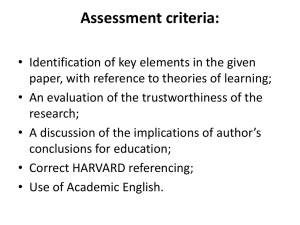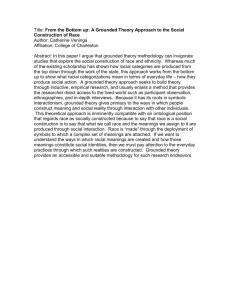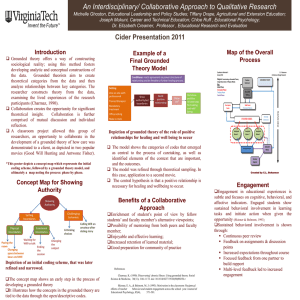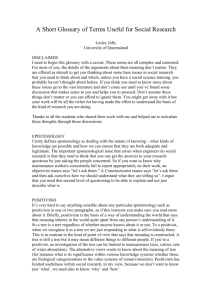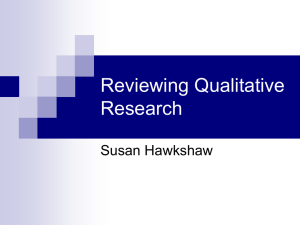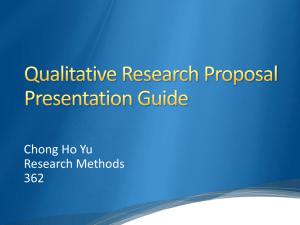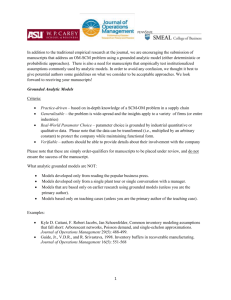The Research Process
advertisement
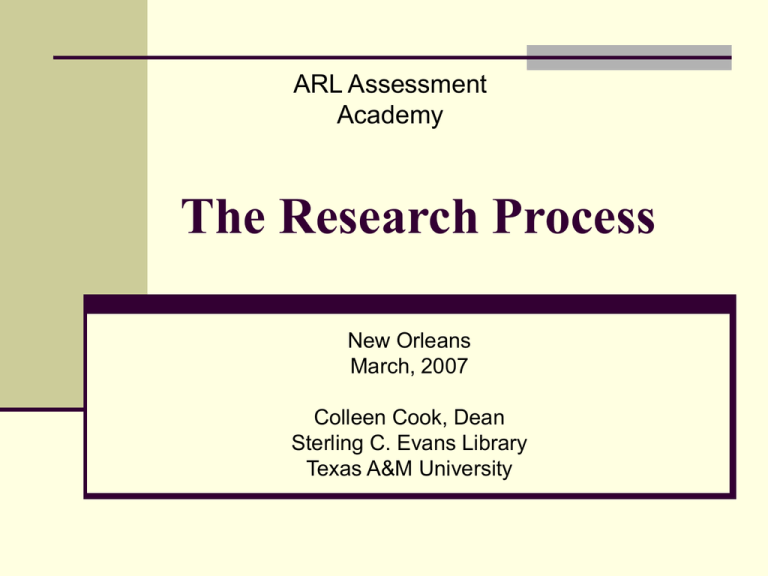
ARL Assessment Academy The Research Process New Orleans March, 2007 Colleen Cook, Dean Sterling C. Evans Library Texas A&M University 1: The Researcher as a Multicultural Subject History and research traditions Conceptions of self and the other Ethics and politics of research 2: Theoretical Paradigms and Perspectives positivism, postpositivism interpretivism, constructivism, hermeneutics Feminism racialized discourses critical theory and Marxist models cultural studies models queer theory 3: Research Strategies study design case study ethnography, participant observation, performance ethnography phenomenology, ethnomethodology grounded theory life history, testimonio historical method action and applied research clinical research 4: Methods of Collection and Analysis interviewing observing artifacts, documents, and records visual methods autoethnography data management methods computer-assisted analysis textual analysis focus groups applied ethnography 5: The Art, Practices, and Politics of Interpretation and Presentation criteria for judging adequacy practices and politics of interpretation writing as interpretation policy analysis evaluation traditions applied research (Denzin & Lincoln, 2000, p.20) Establishing Trustworthiness: A Comparison of Conventional and Naturalistic Inquiry Criterion Conventional Term Naturalistic Term Naturalistic Techniques Truth value Internal validity Credibility Prolonged engagement Persistent observation Triangulation Referential adequacy Peer debriefing Member checks Reflexive journal Applicability External validity Transferability Thick description Purposive sampling Reflexive journal Consistency Reliability Dependability Dependability audit Reflexive journal Neutrality Objectivity Confirmability Confirmability audit Reflexive journal Adapted from Lincoln & Guba, 1985. Summary of Techniques for Establishing Trustworthiness Technique Results Examples Prolonged engagement Build trust Develop rapport Build relationships Obtain wide scope of data Obtain accurate data Length of time in the field Avoiding premature closing Persistent observation Obtain in-depth data Obtain accurate data Sort relevancies from irrelevancies Recognize deceits Purposeful, assertive investigation Triangulation Verify data Using different or multiple sources (interview notes, videotapes, photos, and documents), methods, or investigators Absence of data Referential adequacy Provide a “slice of life” Unobtrusive measures such as brochures, catalogs, year-books, photos, memos, etc. Peer debriefing Test working hypotheses Find alternative explanations Explore emerging design and hypotheses Formal or informal discussion with a peer Summary of Techniques for Establishing Trustworthiness (continued) Technique Results Examples Member checking Test categories, interpretations, or conclusion (constructions) Continuous, formal or informal checking of data with stake-holders such as at the end of an interview, review of written passages, or the final report in draft form Reflexive journal Thick description Document researcher decisions Provide data base for transfer-ability judgments Provide a vicarious experience for the reader Daily or weekly written diary Descriptive, relevant data Purposive sampling Generate data for emergent design and emerging hypotheses Maximum variation sampling that provides the broadest rang of information based on relevance Audit trail Allow auditor to determine trustworthiness of study Interview guides, notes, documents, notecards, peer debriefing notes, journal, etc. Adapted from Lincoln & Guba, 1985. Randolph High School Stability Within Transition The Audit Trail I. A Rich History (p.44) A. Location of the base/the TAJ B. Base description/access C. Base housing description D. History of the base E. Mission of the base/Education of personnel F. History of the school district/funding II. The High School (p.47) A. Perimeter Road 1. Description 2. Stadium 3. Trees B. Campus description C. High school office description/secretaries D. Teachers/ lounge description E. Patio area description F. Main classroom building description/display cases Index Card IA,IB IB IB,IC Photos 4,5,6 6 Artifacts B: Base D:District S: School C: Calendar A: Annuals N:Newspaper B1 B1 B1,D2 IE(1-3) IF(1-2) IIA 8,9 8 IIB(1-2) IIC(1-6) IIE IIF A(1,2),D2,P32 N(34,35,41) 7 10,11,14,80,81 65,66 67,68 15-18,24-28 30-44,49 A(1-5,12) 2,90 III. The Principal—”Do what’s best for the kid!” (p. 51) A. Physical description 1. “Conservative” 2. “Clean-cut” 3. “Honest” 4. “Country Gentleman” 5. “Western-cut clothes” 6. “Never having a hair out of place” 7. “Trim” Excerpted from Skipper, 1989. IIIA2(1-2) IIIA2(1) IIIA2(2),IIIA3 IIIA4 IIIA4 IIIA2(1) IIIA6(1-2) 2,90 2,90 2,90 90,92 A16 Grounded Theory: 1. The aim of grounded theory is to generate or discover a theory. 2. The researcher has to set aside theoretical ideas to allow a ‘substantive’ theory to emerge. 3. Theory focuses on how individuals interact in relation to the phenomenon under study. Grounded Theory: 4. Theory asserts a plausible relation between concepts and sets of concepts. 5. Theory is derived from data acquired through fieldwork interviews, observations and documents. 6. Data analysis is systematic and begins as soon as data is available. Grounded Theory: 7. Data analysis proceeds through identifying categories and connecting them. 8. Further data collection (or sampling) is based on emerging concepts. 9. These concepts are developed through constant comparison with additional data. Grounded Theory: 10. Data collection can stop when new conceptualisations emerge. 11. Data analysis proceeds from ‘open’ coding (identifying categories, properties and dimension) through ‘axial’ coding (examining conditions, strategies and consequences) to ‘selective’ coding around an emerging storyline. 12. The resulting theory can be reported in a narrative framework or as a set of propositions (Dey, 1999, pp.1-2). The End woof


